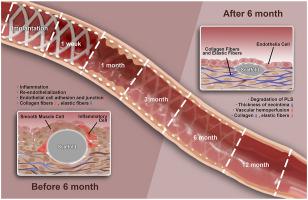Bioactive Materials ( IF 18.0 ) Pub Date : 2021-08-24 , DOI: 10.1016/j.bioactmat.2021.08.020 Tieying Yin 1 , Ruolin Du 1 , Yang Wang 1 , Junyang Huang 1 , Shuang Ge 1 , Yuhua Huang 1 , Youhua Tan 2 , Qing Liu 3 , Zhong Chen 4 , Hanqing Feng 3 , Jie Du 5 , Yazhou Wang 1, 6 , Guixue Wang 1

|
Bioresorbable scaffolds have emerged as a new generation of vascular implants for the treatment of atherosclerosis, and designed to provide a temporary scaffold that is subsequently absorbed by blood vessels over time. Presently, there is insufficient data on the biological and mechanical responses of blood vessels accompanied by bioresorbable scaffolds (BRS) degradation. Therefore, it is necessary to investigate the inflexion point of degradation, the response of blood vessels, and the pathophysiological process of vascular, as results of such studies will be of great value for the design of next generation of BRS. In this study, abdominal aortas of SD rats were received 3-D printed poly-l-actide vascular scaffolds (PLS) for various durations up to 12 months. The response of PLS implanted aorta went through two distinct processes: (1) the neointima with desirable barrier function was obtained in 1 month, accompanied with slow degradation, inflammation, and intimal hyperplasia; (2) significant degradation occurred from 6 months, accompanied with decreasing inflammation and intimal hyperplasia, while the extracellular matrix recovered to normal vessels which indicate the positive remodeling. These in vivo results indicate that 6 months is a key turning point. This “two-stage degradation and vascular characteristics” is proposed to elucidate the long-term effects of PLS on vascular repair and demonstrated the potential of PLS in promoting endothelium function and positive remodeling, which highlights the benefits of PLS and shed some light in the future researches, such as drug combination coatings design.
中文翻译:

3-D 打印的生物可吸收支架的两阶段降解和新型功能性内皮特性
生物可吸收支架已成为治疗动脉粥样硬化的新一代血管植入物,旨在提供一种临时支架,随后随着时间的推移被血管吸收。目前,关于伴随生物可吸收支架 (BRS) 降解的血管的生物学和机械反应的数据不足。因此,有必要研究降解的拐点、血管的反应以及血管的病理生理过程,这些研究结果对下一代BRS的设计具有重要价值。在这项研究中,SD 大鼠的腹主动脉接受了 3-D 打印的聚-l-actide 血管支架 (PLS),最长可达 12 个月。PLS植入主动脉的反应经历了两个不同的过程:(1)1个月内获得了具有理想屏障功能的新生内膜,伴有缓慢降解、炎症和内膜增生;(2) 6个月后出现显着降解,伴随炎症和内膜增生减少,而细胞外基质恢复到正常血管,表明正重构。这些在体内结果表明,6个月是一个关键的转折点。提出这种“两阶段降解和血管特性”是为了阐明 PLS 对血管修复的长期影响,并证明 PLS 在促进内皮功能和正向重塑方面的潜力,突出了 PLS 的益处并在未来的研究,如药物组合涂层设计。











































 京公网安备 11010802027423号
京公网安备 11010802027423号